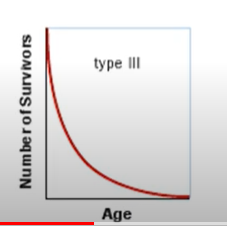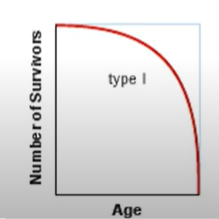Survivorship Curves _ r-/k- strategists
0.0(0)
Card Sorting
1/7
Earn XP
Description and Tags
Study Analytics
Name | Mastery | Learn | Test | Matching | Spaced |
|---|
No study sessions yet.
8 Terms
1
New cards
Survivorship Curves
describe reproductive strategies of organisms

2
New cards
Type III
-Low survivorship at young age
-once at maturity, survivorship = high
-Frogs = lay lots of eggs, some may not hatch.
-oak tree = lots of offspring spread, most may not seed
-young are not equipped to survive at young age
-once at maturity, survivorship = high
-Frogs = lay lots of eggs, some may not hatch.
-oak tree = lots of offspring spread, most may not seed
-young are not equipped to survive at young age

3
New cards
Type II
Survival is likely throughout all stages of life.
-birds, predated upon when young and when mature.
-birds, predated upon when young and when mature.

4
New cards
Type I
Nearly 100% survivorship at young age
-Humans
-still high survivorship at end of life
--> parental investment in life
--> Few young birthed,
-Humans
-still high survivorship at end of life
--> parental investment in life
--> Few young birthed,

5
New cards
r-strategists
make many with few surviving
-little to no parental care
-do well in unpredictable/ changing environments
--> rats = large litter + dandelions = lots of seeds
-little to no parental care
-do well in unpredictable/ changing environments
--> rats = large litter + dandelions = lots of seeds
6
New cards
Organismal Biology
evolutionary approach to reproduction
7
New cards
k-strategists
few with mostly surviving
-reproduce later in life
-longer lifespan
-parental care
- stable environment
--> whale
--> humans
--> elephant
-reproduce later in life
-longer lifespan
-parental care
- stable environment
--> whale
--> humans
--> elephant
8
New cards
Turtle is which strategist?
Bit of both
- lay lots of eggs and leave
(r)
-but live a long time
(k)
- lay lots of eggs and leave
(r)
-but live a long time
(k)